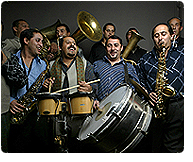|
|
 |
 Gypsy Brass Band Magic in Black America and Unmapped Villages: The Ancient Secrets of Fanfare Ciocarlia
Gypsy Brass Band Magic in Black America and Unmapped Villages: The Ancient Secrets of Fanfare Ciocarlia
When the enslavement of Romania’s Gypsies officially ended in 1864, tens of thousand fled the nation for new horizons. Several thousand landed in the United States, often settling in the black ghettoes of the Southern US states, where they continued to make music. Ioan, Fanfare Ciocarlia’s oldest member and group historian, once answered when asked if jazz was a big influence on the Fanfare, "Who’s to say our cousins who went to the US didn’t help invent jazz?" On Ancient Secrets this matter and other mysteries of Gypsy magic are set forth. -- Garth Cartwright
Zece Prajini—which means ten fields—is a village of 400 souls, surrounded by gentle mountains and dusty tracks. Situated in east Romania, it is less than a stone’s throw from former Soviet republic Moldova. In the evenings, when the winds calm down, the sounds of the fanfare echo from surrounding slopes. This is the home of the twelve gypsy musicians who make up the brass ensemble Fanfare Ciocãrlia whose latest CD is called Gili Garabdi: Ancient Secrets of Gypsy Brass (Asphalt Tango Records; distributed by Harmonia Mundi USA), and who will be on tour across North America this August.
Romany brass bands originate from the Turkish military bands of the early 19th century. The Ottoman occupation of the Balkans had a considerable influence on the music there. Brass plays a central role in the musical life of the region. However, western-oriented bands with electric instruments are increasingly in demand, and are gradually killing off opportunities for traditional brass bands. Bandleader Ioan Ivancea says, “We’re one of the last, and we’re the fastest of them all!”
This art has been handed down from generation to generation. There is no sheet music. The instruments—bearing the marks of the previous decades—have lost their shine and gained their own patina. Fanfare Ciocãrlia manages to set off a musical firework display of traditional dances from Romania and rhythms from Turkey, Bulgaria, and Macedonia. Every weekend the players haul off their instruments to weddings often playing for over thirty hours non-stop. Back in their village they soothe their sore lips and await their next engagement.
With an age range from 23 to 69, there is a wonderful symbiosis between the older and younger musicians. There is respectful silence when old master Radulescu Lazar reaches for his trumpet and strikes up a wild dance. The younger musicians’ eyes narrow dreamily at these sounds as their fingers nervously caress their instruments. The older musicians wink tolerantly whenever the younger generation blasts new sounds through their horns. Since music cannot only be about tradition, they adapt melodies from movies of Bollywood and Hollywood and adapt international radio hits to their own style.
Nowhere else in Eastern Europe is there such a clash of western and eastern musical traditions. In Romania, music still occupies an important place in everyday life. A wedding or other celebration without musicians would be simply unthinkable. Fanfare Ciocãrlia’s thumping bass, driving percussion and spinning horn solos plunge us straight into a wild world of Romanian Gypsy parties. With their debut tour of America and an upcoming film documentary (excerpted on a PC video on the enclosed CD), U.S. and Canadian audiences will finally get a taste of the brass lightning striking across the world.
“Sometimes when I tell people I come from Zece Prajini they think I come from the end of the earth,” says trumpeter Costic “Cimai” Trifan. “But here, at the end of the earth, is the right place to make music.”
|
|
 |
|
|
|